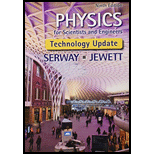
A 2.00-g particle moving at 8.00 m/s makes a perfectly elastic head-on collision with a resting 1.00-g object. (a) Find the speed of each particle after the collision. (b) Find the speed of each particle after the collision if the stationary particle has a mass of 10.0 g. (c) Find the final kinetic energy of the incident 2.00-g particle in the situations described in parts (a) and (b). In which case does the incident particle lose more kinetic energy?
(a)
The velocity of each particle after collision.
Answer to Problem 9.91AP
The velocity of incident particle after collision is
Explanation of Solution
Given info: The mass of incident particle is
Write the condition for velocity of incident particle after collision.
Here,
The initial velocity of the target particle is
Substitute
Thus, the value of
Write the condition for velocity of target particle after collision.
Substitute
Thus, the value of
Conclusion:
Therefore, the velocity of incident particle after collision is
(b)
The velocity of each particle after collision.
Answer to Problem 9.91AP
The velocity of incident particle after collision is
Explanation of Solution
Given info: The mass of incident particle is
Write the condition for velocity of incident particle after collision.
Here,
The initial velocity of the target particle is
Substitute
Thus, the value of
Write the condition for velocity of target particle after collision.
Substitute
Thus, the value of
Conclusion:
Therefore, the velocity of incident particle after collision is
(c)
The kinetic energy of the incident particle in the situation described in part (a) and (b) and the case in which more kinetic energy is lost.
Answer to Problem 9.91AP
The kinetic energy of the incident particle in the situation described in part (a) is
Explanation of Solution
Given info: The mass of incident particle is
Case (a);
From part (a), the velocity of incident particle after collision is
Write the expression for final kinetic energy of incident particle for case (a).
Here,
Substitute
Thus, the value of
Case (b);
From part (b), the velocity of incident particle after collision is
Write the expression for final kinetic energy of incident particle case (b).
Here,
Substitute
Thus, the value of
Since, the incident kinetic energy is almost same in both cases.
The incident particle loses more kinetic energy in case (a) where the mass of the incident particle is
Conclusion:
Therefore, the kinetic energy of the incident particle in the situation described in part (a) is
Want to see more full solutions like this?
Chapter 9 Solutions
Bundle: Physics for Scientists and Engineers, Technology Update, 9th Loose-leaf Version + WebAssign Printed Access Card, Multi-Term
- RT = 4.7E-30 18V IT = 2.3E-3A+ 12 38Ω ли 56Ω ли r5 27Ω ли r3 28Ω r4 > 75Ω r6 600 0.343V 75.8A Now figure out how much current in going through the r4 resistor. |4 = unit And then use that current to find the voltage drop across the r resistor. V4 = unitarrow_forward7 Find the volume inside the cone z² = x²+y², above the (x, y) plane, and between the spheres x²+y²+z² = 1 and x² + y²+z² = 4. Hint: use spherical polar coordinates.arrow_forwardганм Two long, straight wires are oriented perpendicular to the page, as shown in the figure(Figure 1). The current in one wire is I₁ = 3.0 A, pointing into the page, and the current in the other wire is 12 4.0 A, pointing out of the page. = Find the magnitude and direction of the net magnetic field at point P. Express your answer using two significant figures. VO ΜΕ ΑΣΦ ? Figure P 5.0 cm 5.0 cm ₁ = 3.0 A 12 = 4.0 A B: μΤ You have already submitted this answer. Enter a new answer. No credit lost. Try again. Submit Previous Answers Request Answer 1 of 1 Part B X Express your answer using two significant figures. ΜΕ ΑΣΦ 0 = 0 ? below the dashed line to the right P You have already submitted this answer. Enter a new answer. No credit lost. Try again.arrow_forward
 Principles of Physics: A Calculus-Based TextPhysicsISBN:9781133104261Author:Raymond A. Serway, John W. JewettPublisher:Cengage Learning
Principles of Physics: A Calculus-Based TextPhysicsISBN:9781133104261Author:Raymond A. Serway, John W. JewettPublisher:Cengage Learning Physics for Scientists and Engineers: Foundations...PhysicsISBN:9781133939146Author:Katz, Debora M.Publisher:Cengage Learning
Physics for Scientists and Engineers: Foundations...PhysicsISBN:9781133939146Author:Katz, Debora M.Publisher:Cengage Learning College PhysicsPhysicsISBN:9781285737027Author:Raymond A. Serway, Chris VuillePublisher:Cengage Learning
College PhysicsPhysicsISBN:9781285737027Author:Raymond A. Serway, Chris VuillePublisher:Cengage Learning University Physics Volume 1PhysicsISBN:9781938168277Author:William Moebs, Samuel J. Ling, Jeff SannyPublisher:OpenStax - Rice University
University Physics Volume 1PhysicsISBN:9781938168277Author:William Moebs, Samuel J. Ling, Jeff SannyPublisher:OpenStax - Rice University Physics for Scientists and Engineers, Technology ...PhysicsISBN:9781305116399Author:Raymond A. Serway, John W. JewettPublisher:Cengage Learning
Physics for Scientists and Engineers, Technology ...PhysicsISBN:9781305116399Author:Raymond A. Serway, John W. JewettPublisher:Cengage Learning Glencoe Physics: Principles and Problems, Student...PhysicsISBN:9780078807213Author:Paul W. ZitzewitzPublisher:Glencoe/McGraw-Hill
Glencoe Physics: Principles and Problems, Student...PhysicsISBN:9780078807213Author:Paul W. ZitzewitzPublisher:Glencoe/McGraw-Hill





